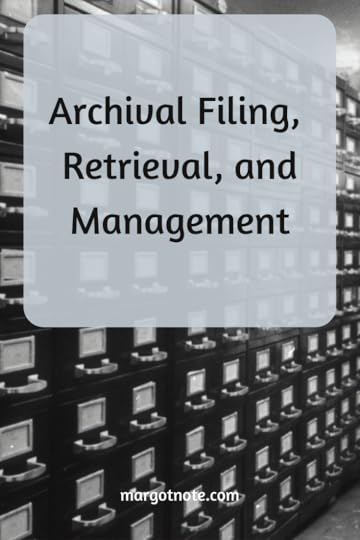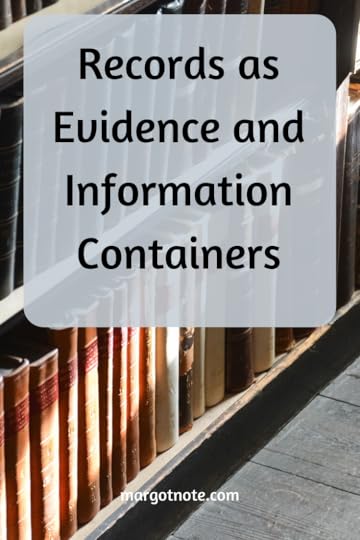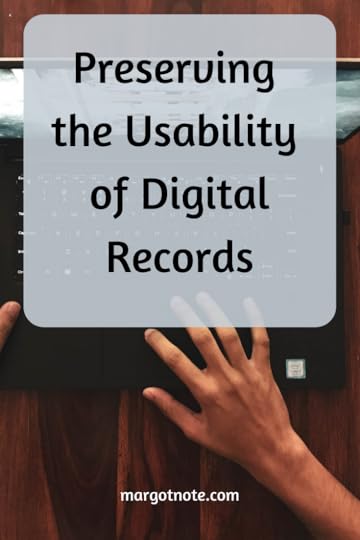Margot Note's Blog, page 20
February 21, 2022
Building Archives Program Support
Few ideas about strategy, goals, and operations for archives result in unanimous agreement. One idea that does? Support the archives program. Support must come from peers as well as those in leadership positions within the organization.
Archivists must understand the organizations’ goals for the archives program, which may differ from their professional goals. The value of archives must be understood by management and staff as a necessary support for the organization’s mission. Each department within the organization has its own needs, and the archives should support those as well. Archivists should send the right message for each type of audience within the organization. Generally, if the connection between the archives department and institutional success is clear, the organization will have an archives program.
The Archival PurposeThe purpose of an archives is to preserve and make accessible an organization’s records of enduring value. Many institutions have established successful archives programs to leverage their most unique and rare asset: their history and legacy. Archives result from an organization’s functions, providing a testament to its core values and mission to shape its future. Since every institution holds a rich history, the benefits of an archival program are independent of size, prestige, and industry.
Like other institutional resources, archival assets assist archivists to:
Reduce operating costs through efficient information retrieval
Contribute to a sound risk management program
Communicate stability in times of change
Maximize the organization’s brand reputation
Provide content for marketing and public relations activities
Strengthen loyalty and pride through showcasing achievements
Preserve memory and organizational heritage
Conduct business intelligence services
Support the legal department
Recognize the accomplishments of employees
Track philanthropic activities over time
Establish business continuity
Centralize and improve the efficiency of information
Other Voices, Other RoomsVarious constituencies within an organization have different views of records—both the active creation of them in their duties, but also permanent records in the archives. Senior management is worried about the bottom line, the overall strategy, and meeting expectations of board members, donors, shareholders, or the public. Middle management is worried about meeting their department-specific goals. Supervisors and managers want things to operate more efficiently to either increase output (effectiveness) or save money (efficiency). Knowledge workers want archives to solve or contribute to solving many of their problems. Employees want their work to be simpler and faster to do.
The archives program can address any or all these desires. To get the support of these groups, archivists need to explain how what they are doing will help. A final note is that while everyone agrees that top management support is necessary, archivists get top management support by proving that they support the other groups listed above. For example, having a manager of a mission-critical department speak up about the value of archival records in a management meeting is the most effective sales pitch for the archival program.
Carrots and SticksCurrently, compliance is a hot topic in information management; compliance and risk mitigation are the focus of many management articles. Compliance is an easy sell. Many new laws have reporting and auditing requirements that make compliance a high-profile issue in many organizations. However, basing an information management program only on compliance is a short-sighted strategy. People only provide the minimum support necessary for meeting a compliance requirement. Compliance is a form of cost avoidance; it does not make for profit. Helping people manage their information better, create better records at less cost, reduce staff time needed for managing records, and improve productivity: all these things add to the bottom line and will increase program support within an organization.
The blog was originally published on Lucidea's blog.
Get StartedLooking for archival advising, records management, and historical research services? Click below to speak with an expert consultant.
Contact
February 14, 2022
Archival Filing, Retrieval, and Management
The basics of intellectual control of records are similar in concept to the levels of archival description with record groups, subgroups, series, and items.
Archivists and records managers need to understand the following to manage and provide access to the records:
The functional activities of the organization and the business processes that create records
The records created by those processes, who creates them, who uses them, and how the records relate to one another
The characteristics of those records, such as retention requirements, vital records status, and restrictions on access
The custodians and locations of the records
Improving an organization’s ability to access its information is one of the key contributions information professionals can make to the engineering or re-engineering of business processes. For example, retrieval can be improved by drafting a taxonomy, a classification according to a predetermined system. However, enterprise-wide taxonomies can be challenging and expensive to implement in any case.
Taxonomy DevelopmentDeveloping a taxonomy must be done in cooperation with the people who use it. Given the amount of work and difficulty in getting user acceptance, the approach must be well thought through before beginning and then reexamined periodically as the work progresses. The work can take years in a medium to large organization, and even in a small organization, a year would not be unusual.
Information professionals should be clear about what problems they are trying to solve with a taxonomy. To what extent does the organization need a common taxonomy across the enterprise? At what level is a common taxonomy appropriate? Here is where the typical archivist’s and records manager’s desires for uniformity and common access points meet each organization’s desire to do what they do and as easily as possible.
Taxonomies are seen as an antidote to the Google approach to information retrieval: index everything and retrieve with some learned capability to rank responses. Google provides information but not context, which is essential for records. Taxonomies provide context by grouping “like” things together. The question is, how does one determine like? For example, in an organization, the news releases may be filed together, the project documents for environmental remediation may be filed together, and remediation production projects may be filed together because each contains records about the same business function. If a user wants to review all news releases (as evidence of business transactions), they will be able to find them. But if they want everything about a remediation site in New Jersey, the taxonomy does not help as much. Most people are searching for information, not transaction records.
Taxonomies work well when looking for evidence or transactions or predicting the requests for information received. If neither of those is true, putting things into categories slows down the search. Information professionals may provide more help with better metadata and better training for users to search effectively.
Metadata CreationMetadata is crucial to managing the lifecycle of a record. Often metadata schema looks at one aspect of a record or information asset. Dublin Core, for example, is focused on making information assets widely available over the web. Its metadata helps identify and describe digital objects but is less valuable when describing records and their relationships to one another.
The problem with metadata is that it is not automatic; it must be collected and entered. People use Dublin Core to describe things that they want to share. They want the document or resource to be found. Hence they may do the work to enter the metadata. Most records creators can find their documents and are not interested in putting in more work to help someone else find them on their own. Archivists must find a way to harvest the metadata for all documents that need to be managed. Records creators will not do it and believe that there needs to be an automated way to do it that requires little human intervention.
The Pay OffThere is a “pay me now or pay me later” aspect to metadata. Everyone understands that adding metadata makes the long-term management of records easier. It is upfront work for long-term gain. Most users opt for paying later–when they are searching–because they do not want to apply metadata now. Partly this is a question of time, but it is more a result of the inability to make adding metadata simple. Records managers, especially, have held on to a model of taxonomy that was implemented in paper by trained staff who did nothing but file. Today information professionals are asking everyone to know enough about records management filing procedures to file correctly. That will not happen. Even automated systems do much better with simple filing schemes.
Good Enough MetadataArchivists and records managers need to determine good enough metadata for management and the easiest way to collect it. Of course, much of the ongoing management metadata can be collected automatically from the systems themselves. Much of it could be system generated. But that still leaves a lot missing, especially for unstructured data. In time, one hopes that collecting and preserving metadata will become easier so that the filing, retrieval, and management of archival materials will become more effortless.
The blog was originally published on Lucidea's blog.
Get StartedLooking for archival advising, records management, and historical research services? Click below to speak with an expert consultant.
Contact
February 7, 2022
Electronic Records and Traditional Archival Values
Retention costs for electronic records are higher than for physical records in every respect, the only exception being the actual space it takes to store digital materials. But that downside is balanced because electronic records allow for the presentation and retrieval of information in ways that have not been possible in an analog world.
Another critical point is that any record series is likely to shift from an analog to a digital format, so the repository will have to deal with the transition unless the decision is made to stop collecting something. In addition, in many cases, a digital record series will incorporate what on paper was several different record series, so teasing out the information required for appraisal decisions becomes more complex.
Archivists grapple with issues and concerns about selecting and appraising electronic records and try to explain how they apply in different institutional environments, types of collections, and what this means for being an archivist in the future.
Machine DependenceDigital media requires hardware and software, which have changed dramatically throughout the years. A collection may have several different formats, with no information about how or when the records were created and not necessarily a way to find out.
Long Term PreservationOnce an archives makes the commitment to acquire a collection containing born-digital records and determines what the records contain, how the files are set up, how they will manage and preserve them, and how they will make them accessible to researchers, they also must commit to keeping them usable over time. To do so requires a significant amount of investment in hardware and software, equipment, skill, and labor.
ManipulabilityDigital records are easily manipulated. Manipulability is a double-edged sword. On the one hand, it increases the ability to use the data as it can be rearranged according to search terms. On the other, it is not always possible to determine its original form.
Traditional Archival ValuesTraditional archival theory remains relevant in the digital world. Think of how the characteristic of being born digital would affect the assessment of evidential and informational value. Do the more complicated ways multiple creators produce electronic records clarify or muddy the waters in terms of evidential value? Does manipulability bring informational value into question? Are these records more revealing because their creation, if appropriately documented, reflects modern social and organizational structures? Think of all the extra information in an email message beyond the actual content.
Archivists care about how records were created: the levels of activity within an organization, importance of that activity, uniqueness of information, the usability of information, and relationship to other records, as well as research value. These factors help archivists appraise records and make selection decisions.
In a digital environment, traditional archivists will always be needed. In other words, paper is not going away, but archivists now must be able to meld approaches for both–sometimes in the same collection.
The Postcustodial EraElectronic records are opaque, difficult to investigate by topic, and the emphasis must be on provenance and context. As a result, archivists have moved into a postcustodial era. While they may argue about the realism of records creators taking sufficient interest in the long-term preservation and access to their records, the fact that records do not become noncurrent according to the same life cycle means that more interaction with records creators is crucial at least in an institutional environment. The advantage of a postcustodial approach is that if the information is essential to the records creators, they will maintain the systems to keep it accessible.
Part of dealing with context is mapping relationships, which includes making connections among actors that illuminates provenance and context. This emphasis shifts attention away from the traditional archival functions of gathering, arranging, and describing records. Instead, it moves us towards how society (and its individual and institutional members) record, use, store, describe, and dispose of information. That translates into recordkeeping and helps us understand how the systems are being set up.
Content, Context, and StructureRecords have three components: content, context, and structure. All three components also exist in analog files but with more transparency. The complications for appraisal in an electronic environment include not having records stored in one physical location; the content may not be all together, but stored in different places and logically imported into documents or attachments; the form and content are not constant; software changes can alter how the system works, and can alter data values and relationships. The advantage to figuring all this out is the value-add that archivists can provide by understanding these relationships and the information world within an organization.
The blog was originally published on Lucidea's blog.
Get StartedLooking for archival advising, records management, and historical research services? Click below to speak with an expert consultant.
Contact
January 31, 2022
Supercharge Your LIS Career
A couple years ago, my friend Tom Nielsen and I presented a session, You and Your Career, at the Special Libraries Association annual conference in Phoenix, Arizona. In the workshop, we discussed the myriad of ways in which LIS students and early career professionals can take their careers to the next level. The goal of the interactive class is to prepare current and future information professionals by:
increasing their self-awareness and their understanding of their working preferences
improving their knowledge of professional workplace skills
developing an understanding of the many ways that they can engage professionally within the field.
It was my first time attending an SLA conference, and I met great people and learned a lot that I can bring back to my consulting business. I also survived multiple days of almost 120-degree heat! The two-block walk from the hotel to conference center was eye-searing!
Tom and I divided the session into three modules that examined participants as individuals, employees, and professionals. Imagine a Russian nesting doll. At your core, you are yourself with all of the insights and experiences that make you "you." The next layer is who you are as an employee, working at your current position within the culture of an organization. The very last layer is who you are as a professional: how you navigate, pivot, and flow through your career and the story it tells about you as a knowledge worker.
Attendees explored how a deeper understanding of themselves allows them to perform at their best level workwise. Then they shifted their focus to workplace best practices that they can employ throughout the lifecycle of a job. Also reviewed are ways in which librarians and archivists can become more involved in their field through professional development opportunities that play to their strengths.
We had originally planned to do small group activities and full class brainstorms to facilitate the discussions. Instead, given the small class size, we were able to have a much deeper and targeted discussion with the participants.
It was our first time facilitating the workshop, and I'm thankful that we received great feedback to make the class even better. For example, when we originally created the workshop, we focused on library science students and early career professionals. Of course, career changers would benefit from the workshop as well; many people become librarians and archivists as a second career. I'm looking forward to improving the class and teaching it again soon!
To provide some resources beyond the session, I created a list of further readings, divided into three sections:
You as an IndividualThe Best Jobs for Every Personality Type
This infographic from Business Insider shows each of the 16 Myers-Briggs personality types and the jobs recommended for each type.
Career Assessment Tools & Tests: Assessments for Students, Job-Seekers, Career-Changers:
From career development and job-hunting site Quintessential Careers, this site provides a good starting point for finding a multitude of personal and career assessments.
An extensive collection of information resources related to the Keirsey temperaments, such as artisans, guardians, idealists, and rationales, plus role variants within temperaments.
Motivational Appraisal of Personal Potential (MAPP)
The MAPP assessment measures your potential and motivation for various types of work while profiling your temperament, aptitude, and possible career matches.
A comprehensive collection of information about the Myers-Briggs personality type test, including the assessment tools, results interpretations, and information on how to use your results.
Personal SWOT Analysis: Making the Most of Your Talents and Opportunities
This article and accompanying worksheet will help you identify the key questions to ask yourself to unearth the information most useful for making career decisions.
A site that provides information about the multitude of personality assessments and types, describing the lingo used by the most popular assessments to help you understand both your outcomes and those of others.
“Personality Types and Librarians” (Part 1) and (Part 2)
A terrific overview of librarians’ MBTI statistics and the impact of those stats on potential career choices.
You as an EmployeeCareer Q&A with the Library Career People
A monthly career question-and-answer session with Tiffany Allen (director of Library HR, University of North Carolina, Chapel Hill University Library) and Susanne Markgren (digital services librarian, Purchase College, State University of New York).
Emerging Career Trends for Information Professionals
This annual recap from the San Jose State University School of Information provides not only job titles but also job trends for the current information career universe. The report also identifies many of the requisite job skills for specific LIS roles and the skills hiring managers are currently emphasizing based on an analysis of LIS and general job posting sites. Especially valuable for those considering nontraditional career paths.
How to Become a 21st Century Librarian
A resource for those considering traditional librarianship, but also a great reminder of why library work can be so rewarding.
A LinkedIn group focused on every possible aspect of LIS career options, whose members include students, practitioners, those considering librarianship, LIS recruiters, and vendors.
Making the Shift: Using Transferable Skills to Change Career Paths
An overview of how to use transferable skills to create career path options.
Navigating the Salary Question
Excellent source of specific language to use when attempting to navigate the salary question during the initial interview.
An Open Letter to New Librarians
An honest response from technologist and LIS thought leader Roy Tennant on dealing with the frustrations facing many recent graduates and others new to the library profession.
You as a ProfessionalAsking to Connect on LinkedIn—Words to Use
One of the important aspects of networking on LinkedIn is reaching out and establishing links to others. This blog post gives examples of wording you can adapt to tailor your request for the individual you’re reaching out to.
Creating a Positive Professional Image
Discussion of the most important elements of creating a strong professional brand, building credibility, and maintaining authenticity.
How to Be a Leader in Your Field: A Guide for Students in Professional Schools
Thoughtful and practical advice during graduate school tenure and subsequent career
How to Build a Meaningful Career
A practical exploration of purpose as it relates to the work we choose to do, how we do it, and how it supports our human need for meaning in our lives.
This article, written by Brian Uzzi and Shannon Dunlap, is an exploration of how information and connects flow based on the nature of those connections.
A methodically, well-organized overview of how to think strategically about the various aspects of your network and how to gain the most benefit from each of those aspects
This post addresses a phenomenon often experienced by individuals who are promoted to positions of leadership and authority. This is an especially significant concern if you are trying to build confidence and courage.
An article on why “weak ties” or connections of people outside your normal sphere of influence and engagement can provide to be a highly effective way of opening up additional career opportunities as well as extending your access to knowledge and insights outside your immediate professional community.
What's NextWhat career resources have you found helpful?
[image error]January 24, 2022
Protect Your Past
Your life is an epic. To those who love you, and to generations yet to be born, it's as enthralling as a bestseller. It's a composition crafted since before you entered the world--and it's still being written.
The words are your family stories, your parents' love letters, and your journals in the attic. And the images are your photos pasted in albums, piled in drawers, and packed in the cellar. Each artifact tells a fascinating tale, including how and why it survived generations.
Who will pass on these memories to your loved ones?
My guide will help you create your legacy. You'll learn how to protect your cherished family treasures with techniques that professionals in the finest museums use. These solutions are easy, inexpensive, and crafted especially for you.
You'll understand history as you never had before. You'll discover the traits, temperaments, and talents that link generations. You'll realize that you're a member of a group larger than your family. You're part of history.
Preserving memories brings joy to thousands of lives. Are you ready to protect your past, enrich your present, and inspire hope for your future?
To learn the preservation secrets used by libraries, archives, and museums to protect their priceless materials (that you can also use for your family heritage items) read my book: .
Creating Family Archives: A Step-by-Step Guide to Saving Your Memories for Future Generations By Margot Note Buy on AmazonReady to get started creating your family archives? Here are some of my favorite products:



January 17, 2022
Reviewers Love Project Management for Information Professionals
In the October 2016 issue of Library Resources & Technical Services, the official journal of the Association for Library Collections & Technical Services, Chelcie Juliet Rowell, Digital Initiatives Librarian at Z. Smith Reynolds Library at Wake Forest University, writes in her review that Project Management for Information Professionals:
is clearly envisioned and executed as a handbook for librarians, archivists, and curators who find themselves leading project-based work. By empowering individual information professionals to manage projects more effectively, this work may play a part in shifting the organizational culture of memory institutions: from taking a defensive stance within an information environment in constant flux, to embracing project-based work as a way for libraries, archives, and museums to learn and grow and vitally engage the communities they serve.
Note is the consummate project manager, and it shows in her handbook of project management for information professionals. This book knows what it is, and what it is not; it remains true to its project scope. It achieves its objectives, and delivers what it promises to its readers. Novice project managers will keep it close at hand; more experienced project managers will consult it when they feel themselves becoming stuck and will look back at past projects with a sharper eye for what they might do better.
Writing is a solitary endeavor. You hope that your work will resonate with people, especially with librarians, archivists, and other information professionals who may already be stretched thin at work. You want to solve their burning pains and simplify their work. Nothing makes me happier than when my readers reach out to me to tell me about how my books helped them, when I'm cited in other books, or when I get positive reviews. I hope this is the first good review of many!
Project Management for Information Professionals By Margot Note Buy on Amazon
January 10, 2022
Records as Evidence and Information Containers
How do we want to manage archival records? What foundational ideas–the theory and principles of archival science—support archivists’ work?
The Traditional Archival and Records Management ViewThe traditional archival and records management view looks at records primarily as evidence of transactions. This view excludes information assets that are not “evidence of transactions” from the scope of records and archival management, and that is how these fields looked at it for many years. Although it was not explicitly phrased, the essential position was that they should be managed as paper was managed–using detailed file plans and records schedules–and that was the mental model behind the creation of records management applications. Organizing records according to a structure and mandating retentions based on content and function are sound principles, but they need to be adapted to the electronic era.
File plans and records schedules have divided the records into small units of the shortest retention allowed. The classic rule for constructing file plans was that if a subject file grew to more than ¾ inch, it should be subdivided to make the paper files easier to search. However, the major problem with the records as evidence view is that the information container side of the coin is often lost. Records are organized to provide context first and information second. Records are filed by transaction and indexed to allow certain types of information to be linked across files. That approach can be adapted to the digital world, but it requires rigor in assigning metadata that is frequently not done.
The Information Resources Management ViewThe information resources management (IRM) view seeks to manage records like data. A good IRM program knows its data, stores it economically (e.g., hierarchical storage), maintains data integrity and security, and promotes system flexibility and appropriate data sharing. In many ways, these goals make clear ideas implicit in records management goals but are based on data (records) as information assets, not evidence. The IRM approach focuses on managing digital objects as information containers and ignores the evidence of transactions component of records. That is evident in things like data warehouses and mashups that permit the analysis of data stripped of elements of context that are necessary for evidence. Finally, the IRM view does not look at preserving digital objects beyond the immediate need for them as information containers.
The User ViewThe third view is that of the user. Users rarely think of the materials they have as records, which is especially true of digital objects. Their approach to organizing and maintaining documentation of any kind is for reference and reuse. Once a document has been submitted, they see it as someone else’s responsibility to maintain the official record.
Users have three options for managing their information. First, they can print on paper. If the user does see a need to maintain a record, paper is often the “medium of record.” Their files may or may not correspond to the filing system the office uses.
Information may also be maintained on the local hard drive, removable media, or another storage device. The digital objects are maintained for the personal use of the user and organized to suit operational needs. There is rarely any real management here; there is a lack of standard structure, metadata, naming conventions, and regular backup. To the extent that these things are done, they are done according to a system developed by the user to meet their needs and work habits. In this scenario, the user is the only one who can reliably locate and provide access to their records.
Another option is to maintain the digital objects on a network server. Maintaining files on the network server ensures regular backup and the ability for others to access the files. However, a different question is whether there is sufficient uniform structure to provide the necessary context for records. Some applications, such as SharePoint or content management solutions, provide tools to manage records better, but how those tools are used depends on which of the three perspectives is adopted for managing digital objects in SharePoint.
Evidence and Information ContainersThe more modern view is that records are both evidence and information containers. Records and other digital assets are tied to a process or function first. The trick is to organize them by transaction, ensuring their authenticity, reliability, and integrity, but facilitate access for their informational value since that is the way they are most often used. To do this means that archivists and records managers must team with specialists in providing access, IT and security staff, and specialists in access restrictions (such as legal counsel) to provide the expertise necessary to advise the program staff on how to make the best use of the records they create and use.
The blog was originally published on Lucidea's blog.
Get StartedLooking for archival advising, records management, and historical research services? Click below to speak with an expert consultant.
Contact
January 3, 2022
Preserving the Usability of Digital Records
With regard to digital records in archives, there is a three-tiered approach to thinking about what needs to be preserved. Each of these three levels of usability represents a valid preservation goal, depending on why keeping organizational records is necessary.
Information, PleaseThe first level is providing information. At this level, the records must have sufficient usability to enable users to provide answers to questions and provide raw materials for research and reuse and a historical record of what took place.
Institutional memory is the most common requirement from a user perspective. They want records preserved so that they can find the information when needed and repurpose it if possible. It is also the easiest to satisfy because there is no need to worry about the authenticity and integrity of the information. Authenticity is assumed—when it is considered at all. Users are interested in knowing what version of a document is final, but that is more of an active than an inactive records management issue. The key demands are that the records be maintained in a format that meets user needs and that they are easily located when needed. These requirements may be satisfied by making sure that the files are viewable, searchable, and, in some cases, capable of being copied and reused in whole or in part.
There are several options for long-term retention in this scenario that will meet an organization’s needs because the records are being treated primarily as information assets, not as records with demonstrable authenticity and reliability. Organizations following this model are doing one of three things.
One is ignoring the question altogether, simply assuming the authenticity of their records without having the ability to demonstrate it. This may be a conscious, risk-based decision or simply ignorance of the risks they are taking.
Another is maintaining in hard copy those records necessary to satisfy legal, financial, or similar purposes where demonstration of authenticity is required. Unfortunately, it is increasingly unlikely that this is possible, except for the smallest organizations, since so much information is maintained only electronically.
Lastly, another is segregating out the small percentage of electronic records whose authenticity and integrity must be demonstrated for extended periods and handling most digital objects as information assets.
Authenticity, Reliability, Integrity, and UsabilityThe second level serves as the official legal record of activities. Records must have demonstrable authenticity, reliability, integrity, and usability. The records support the ongoing operation of the organization, serve as the legal record of the transaction or a portion of it, and permit oversight and support accountability.
Usability PlusThe third level raises the bar because preserving a record’s usability as evidence requires more stringent procedures than maintaining its usability solely for informational purposes. In addition, preservation of a record’s authenticity, reliability, and integrity requires additional controls in the preservation process and may limit the preservation tactics that can be used or add to the cost and complexity.
The third level allows for the recreation of the transaction to check the validity of the results. To preserve records at this level will usually require maintaining the functionality of the original application or system. For example, functionality is critical for computer models, geographic information systems, or other applications where data manipulation is intrinsic to creating a record. In the case of a desktop application, archivists consider maintaining the original look and feel of the archival materials. Preserving how information was stored and displayed is a complex task, but it defines usability.
Building Upon Each OtherThese levels of usability can build upon each other. For many organizations, the first level may be suitable—or, at the very least, achievable. Then, as the organization matures and the archival department becomes more skilled, they can aim to achieve higher levels if necessary.
The blog was originally published on Lucidea's blog.
Get StartedLooking for archival advising, records management, and historical research services? Click below to speak with an expert consultant.
Contact
December 27, 2021
Career Advice for Archivists
The past several years for me have been quite a journey. I started my own consulting business, wrote a few books, started teaching at universities, worked with a number of clients, and expanded my professional network substantially. I also shared some of the lessons I learned from working as a self-employed archivist. Here are some of the most popular posts on my career advice.
December 20, 2021
Finish Your Genealogy and Family History Projects in 2022
I've written a lot about family archives over the years, but sometimes my readers miss a post or are new to my community. I've listed my posts related to how anyone can learn methods to save their personal and family history.
Learn the preservation secrets used by libraries, archives, and museums to protect their priceless materials (that you can also use for your family heritage items) by ordering my book:
Creating Family Archives: A Step-by-Step Guide to Saving Your Memories for Future Generations By Margot Note Buy on Amazon


